Would you like to sew a jacket that cuts a fine figure for every occasion? Then you’ve come to the right place with the “Lois” jacket. The designer Marijke van der Veen has created a stylish overcoat that even beginners can sew thanks to the simple instructions plus video and the many tips and tricks. Let yourself be inspired!
Sewing is your passion, but you haven’t dared to wear a jacket yet? Designer Marijke van der Veen has created a chic and easy-to-sew jacket without a zip and hood, which even beginners can sew with. In the instructions with video, she shows you step by step how you can easily sew the “Lois” jacket. Lois is available in sizes 36 to 56 – every body is unique and beautiful and can be perfectly staged thanks to the clever cut.
Sewing the “Lois” jacket: preparation + pattern © Marijke van der Veen
The overcoat is a model made of a combination of leather and tricot fabric – noble and casual at the same time and therefore suitable for every occasion! Due to the unusual design in which the Sleeves and back parts made of a stretch fabric such as B. Punta di Roma this model wears like a light cardigan but has the look of a chic blazer. The jacket has no fastener and is therefore easy to sew. If the fabric is suitable for this, the front part can be finished with an open edge, which makes the jacket nice and light and has a sporty look. Double processing gives the garment a finer appearance.
Lois comes in two variants:
- A = a shorter length
- B = a waist length version.
Sketch variant A+B:
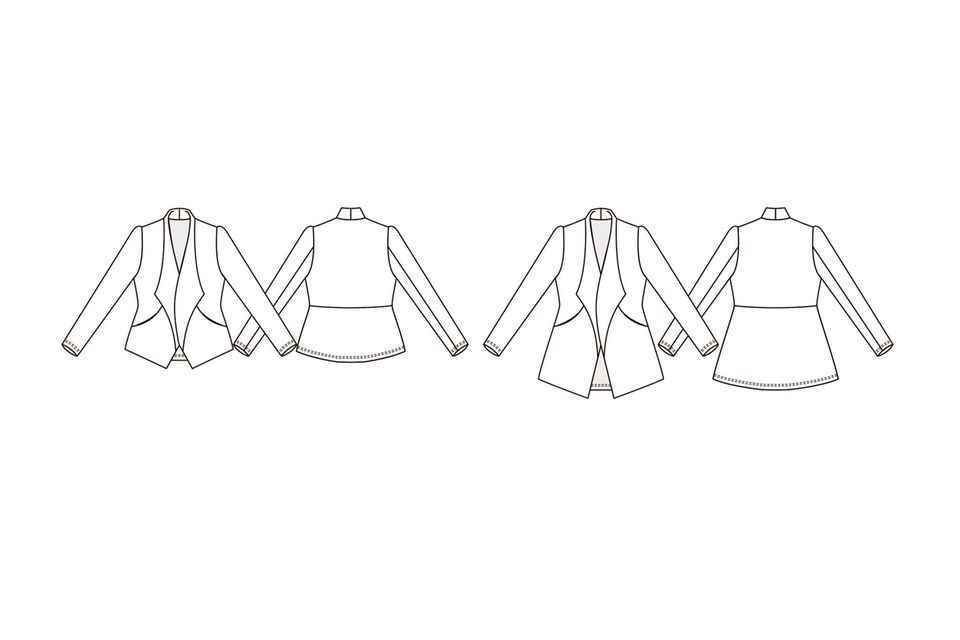
© Marijke van der Veen
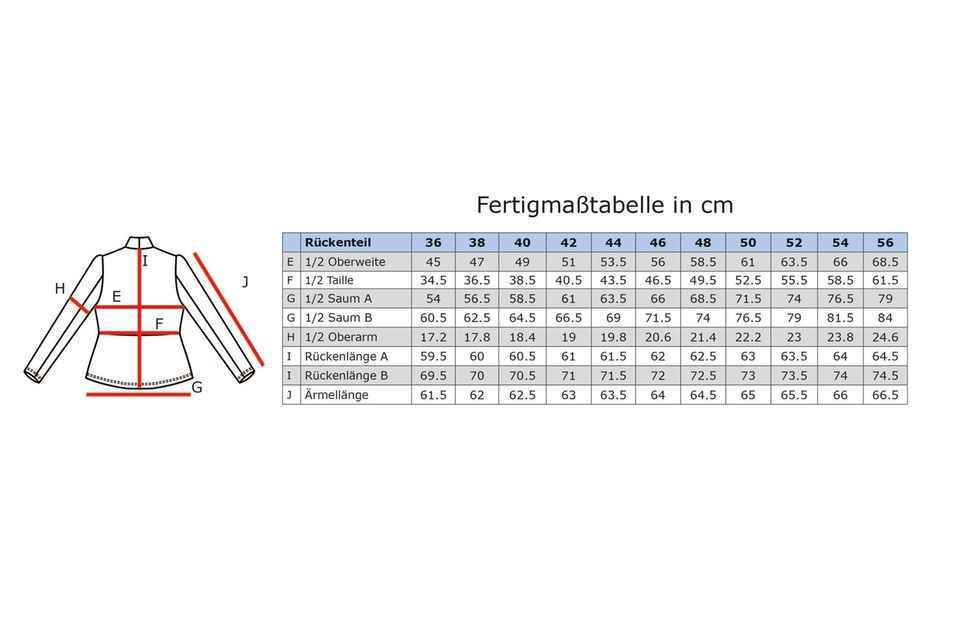
© Marijke van der Veen
Pattern: The pattern for this easy to sew jacket is as A4 PDF available. You can print it out yourself in PDF format. Note that you can download the pattern with or without a seam allowance. The PDF pattern includes 23 pages and consists of layers. This makes it possible to print out just the size you want when opening it with Adobe Acrobat Reader. This program can be downloaded for free. Would you like to learn how this works? Enjoy watching this one Video on.
You can also find that here Pattern as A0 (without seam allowance)to have it printed out at a copy shop. Also, you can also below the projector file (with seam allowance) download.
A notice: in the Sewing pattern with seam allowance 1 cm seam allowance and 2 cm hem allowance are included.
Print overview:
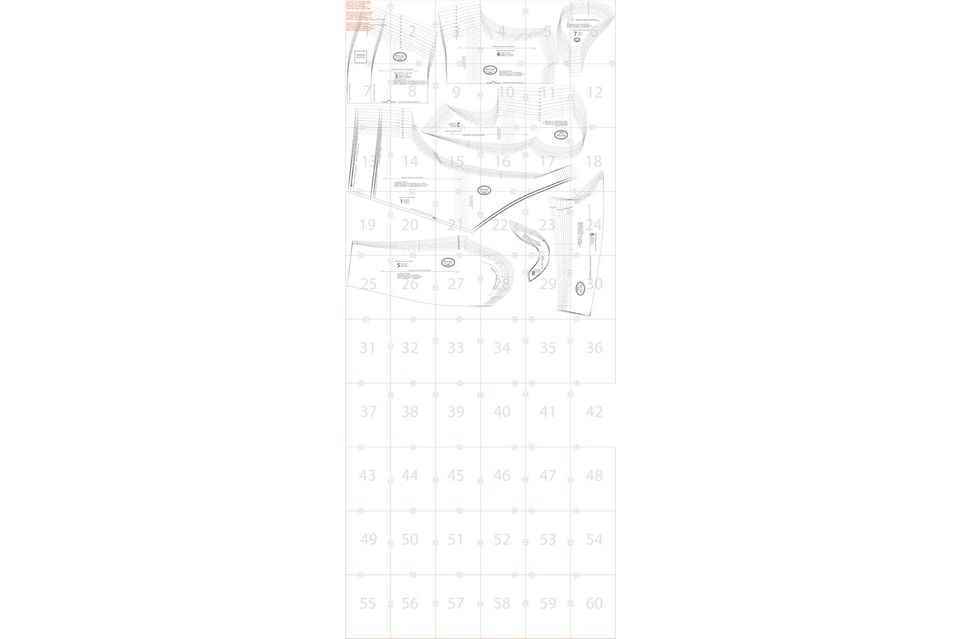
© Marijke van der Veen
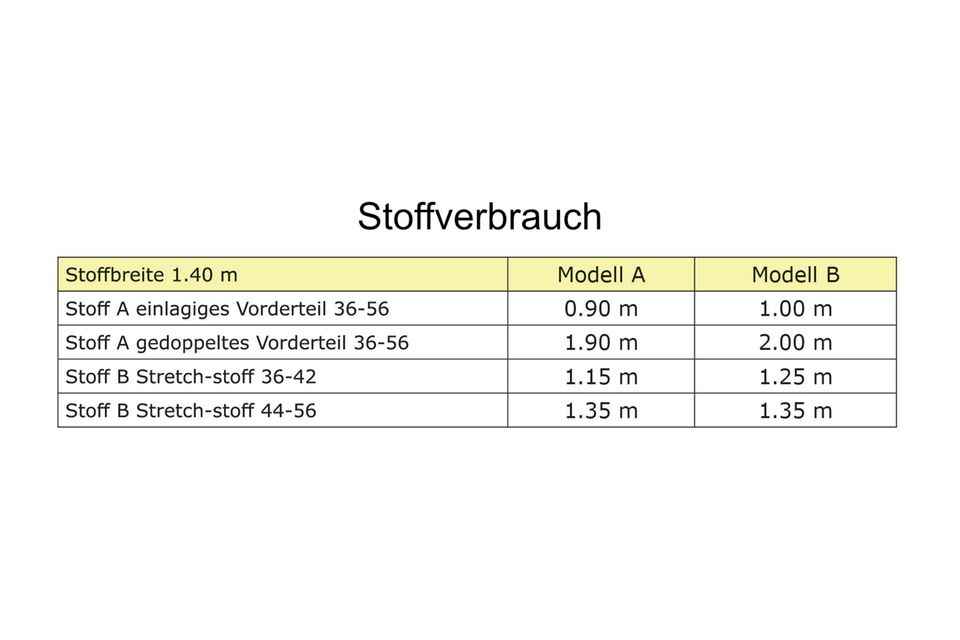
© Marijke van der Veen
Note on processing: You can finish this jacket with an open edge in the front with just one layer of fabric if the fabric is suitable for this. With this raw-edged finish, the back of the fabric is visible, so the edges must not fray. The front part is cut twice at the front edge without a seam allowance. To do this, cut off the 1 cm seam allowance at the front edge of the front piece.
If you prefer to work the jacket with a doubled front part and a folded edge, the front parts are cut 4x with seam allowance.
You need:
- Twin needle with 3 mm needle spacing
- shoulder pads
- Textile glue stick (e.g. from Prym)
Fabric recommendation:
- Use for Fabric A synthetic or suede with a beautiful back, slightly falling and not fraying. Of course, you can also use other suitable materials, e.g. B. Use Walkloden. If the fabric does not have a nice reverse side, it is better to double the front.
- vote for Fabric B is a stiffer, stretchy tricot fabric like Punta di Roma or French Terry.
Important: The pattern is only suitable for stretchy fabrics!
Pattern pieces fabric A (artificial or suede):
- 1: Front part, 2x for raw-edged processing or 4x for double processing
- 2: side front piece with cut pocket pouch, 2x
Pattern pieces for fabric B (tricot fabric):
- 3: lower back part, 1x in the fabric fold
- 4: upper back part, 1x in the fabric fold
- 5: upper sleeve, 2x
- 6: under sleeve, 2x
- 7: pocket pouch, 2x
- 8: sleeve cap cover 2x
Crop + Preparations:
- Cut the pattern pieces according to the cutting list.
- Note:The sewing pattern with seam allowance includes 1 cm seam allowance and 2 cm hem allowance.
- All seams are sewn right sides together unless otherwise noted.
- Transfer the marker point from front piece 1 to the wrong side of the fabric.
- The seams can be sewn with an overlock machine or a small zigzag stitch.
- To avoid unsightly ironing through of the seams, we recommend placing an ironing cloth or a thin drying cloth between the iron and the fabric.
Cutting plan A with single-layer front piece and open-edged processing:
In this variant, the front part consists of one layer of fabric and has an open-edged finish.
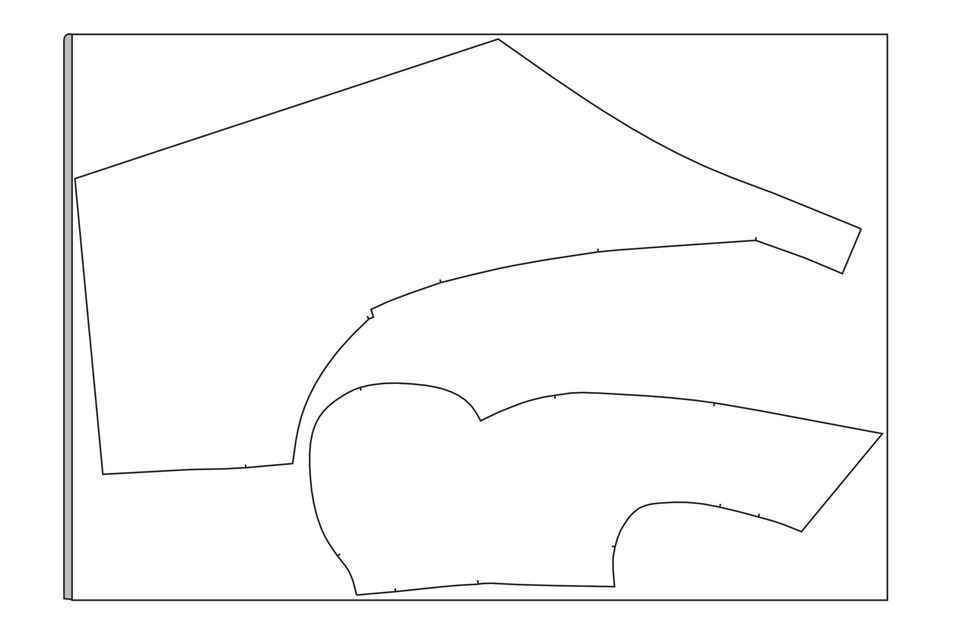
© Marijke van der Veen
Cutting plan A with double front piece:
In this variant, the front part consists of two layers of fabric.
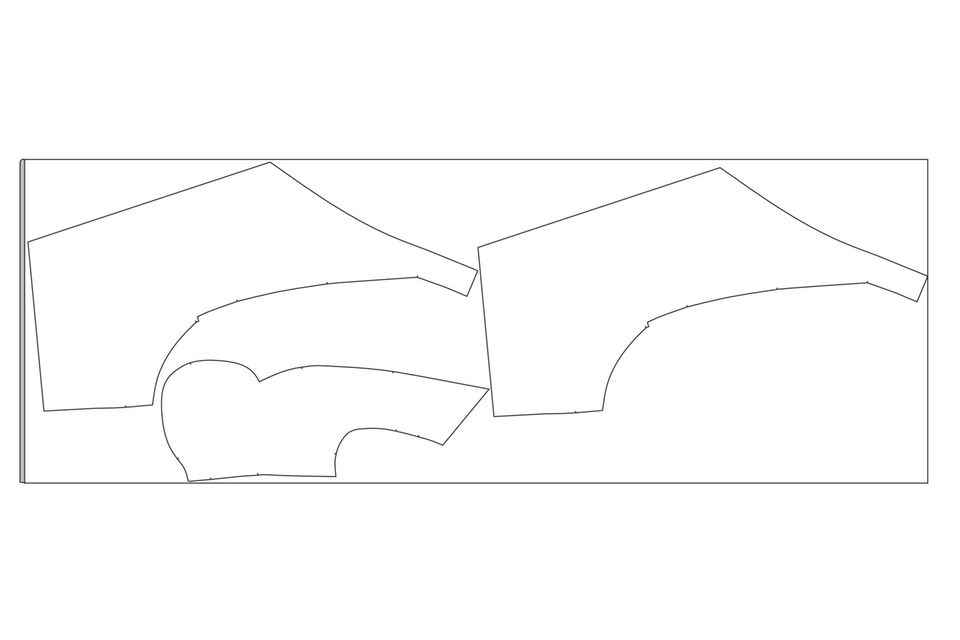
© Marijke van der Veen
Cutting plan B:
Cutting plan B size 36-42
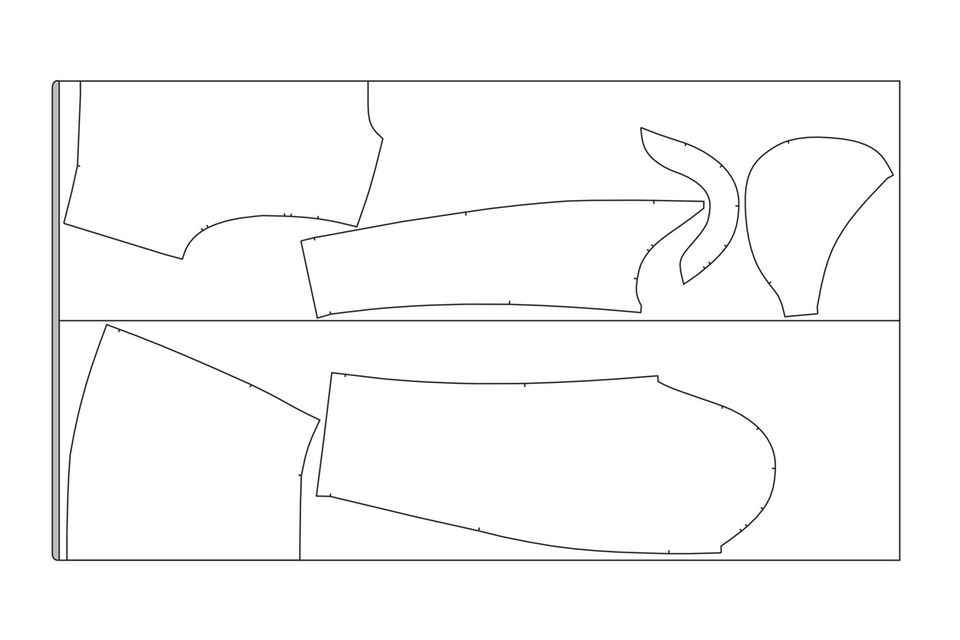
© Marijke van der Veen
Cutting plan B size 44-56
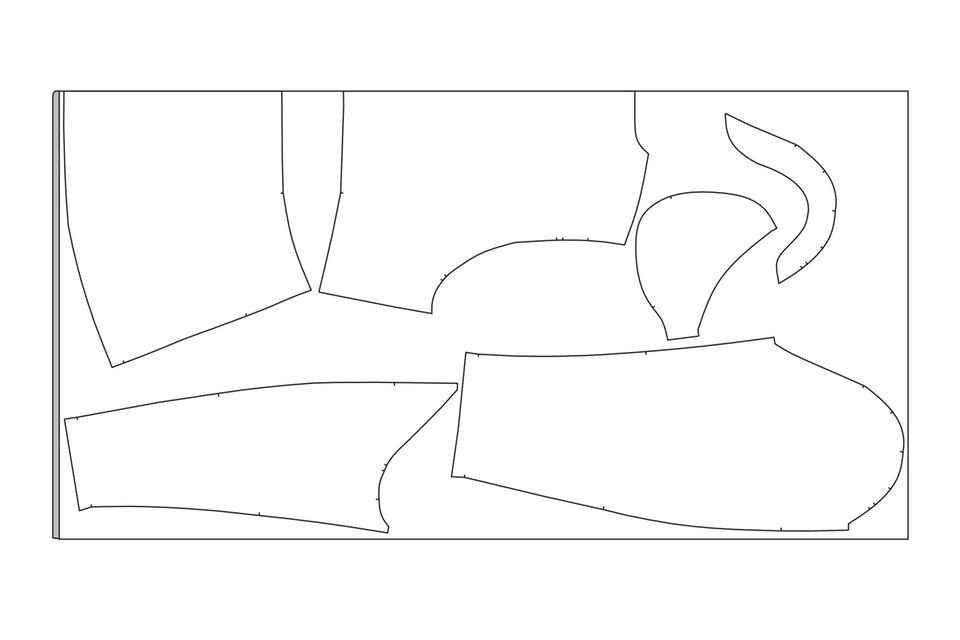
© Marijke van der Veen
All seams marked red on the pattern can be sewn on a regular sewing machine with a stretchy stitch and 1cm seam allowance.
If you want to sew the jacket with the overlock machine, please note that most overlock seams are automatically only 7 mm wide.
The edges of the parts outlined in red are neatened before sewing:
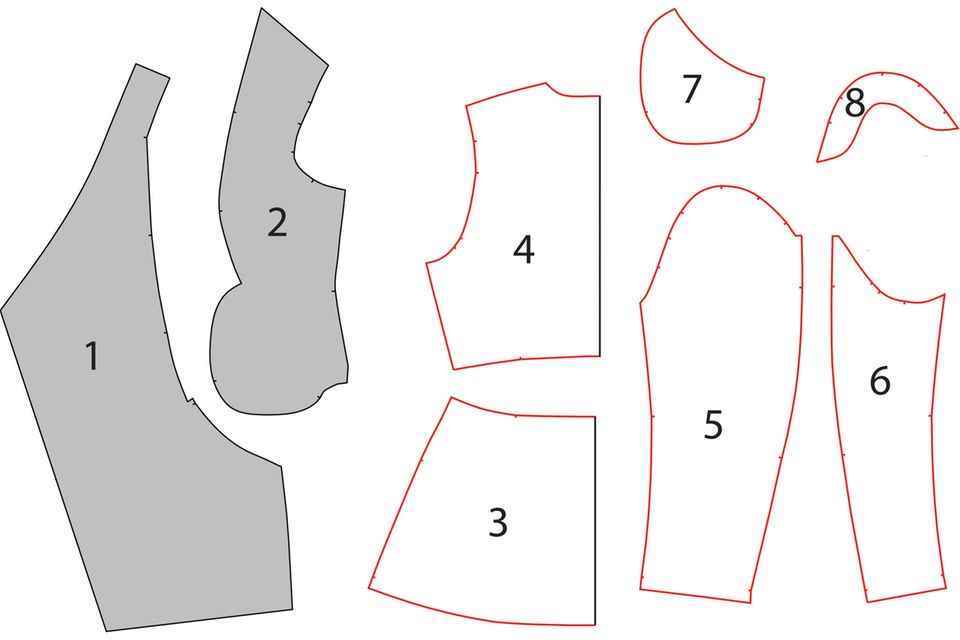
© Marijke van der Veen
Sewing a jacket: Instructions for the “Lois” jacket
Processing of the jacket with double front part:
- Sew the center back seam of the collar cut at the front and carefully iron the seam apart. If your suede or imitation leather is difficult to iron, you can fix the seam allowance with the help of the Prym glue stick.
- Then place the two front pieces right sides together and sew the two pieces together from the bottom side seam along the front edge and back collar seam to the other end of the bottom side seam. Cut back the corners at an angle. Then the seam is ironed apart or fixed with a glue stick and the front part is turned. Then carefully iron the seam from the right side as flat as possible.
- Then the jacket is assembled in this order: Sew together the waist seam of the upper back piece 4 and lower back piece 3 and iron them flat.
- Now sew the pocket part 7 to the front part 1 and iron the seam flat.
- Place front piece 2 on top of front piece 1 and close the dividing seam and the pocket at the same time. Sew up to the marking point, sink the needle into the fabric, lift the foot and turn the front part to be able to close the bag.
- Carefully iron the seam forwards with a pressing cloth in the direction of the front part 1 and iron the pocket opening flat. Depending on the fabric, the pocket opening can be overstitched to make it look nicer.
- Now place the front pieces right sides together on the back piece and close the side seams. Fold back the attached collar and sew up the shoulder seams. The last centimeter before the neckline remains open. Iron the seams flat.
Open-edged processing of the jacket with a single-layer front part:
Close the back seam of the collar cut on the front part 1 and carefully iron the seam apart. If your suede or imitation leather is difficult to iron, you can fix the seam allowance with the help of the Prym glue stick or overstitch to about 7mm on both sides.
Collar:
Sew the attached collar from front part 1 to the back neckline.
Sleeve:
1. Put a gathering thread in the armhole of the sleeve. The section is marked by a wavy line. For gathering, the seam is not bar-tacked and the longest stitch length is set. By gently pulling on the lower thread of the ruffled seam, the arm cap can then be slightly ruffled.
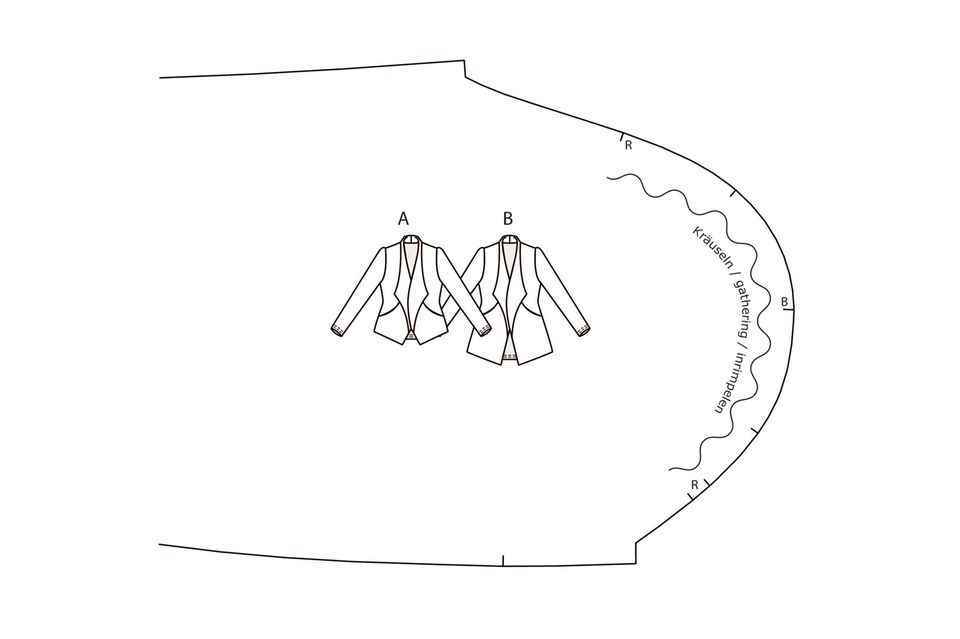
© Marijke van der Veen
2. Sew the underarm and upper arm seams of sleeve parts 5 and 6 together and iron the seams apart.
3. Turn the sleeves to the right and then pin them into the armholes of the jacket, right sides together. Make sure that you do not mix up the sleeves and that the back sleeve is attached to the back part. The back part and the back sleeve both have a double snap. These double snaps must be on top of each other.
4. First, the side seam snap A is pinned to the side seam, then the shoulder snap B of the sleeve head is pinned to the shoulder seam and then all the snaps in between are pinned on top of each other.
5. The cap of the arm has more width than the armhole, so it is ruffled a bit.
6. It is important not to stretch out the sleeve as you sew it in. This works best if the sleeve is on top when sewing. For very stretchy fabrics, we recommend reinforcing the armhole with an iron-on shaping tape to prevent stretching.
7. Now carefully sew the sleeve into the armhole, the sleeve is on top and make sure that all the snaps are on top of each other. If a small crease forms, you can carefully push it aside with the scissors.
8. We recommend inserting the sleeve with a regular sewing machine and a 1cm seam allowance, as small creases and mistakes can be separated more easily than with an overlock seam.
9. Then check whether any creases have formed. Then insert the sleeve cap slip 8 into the sleeve cap. Sew the facing 8 to 7mm from the edge into the sleeve cap with the sleeve facing up so the sleeve inset seam is clearly visible. Iron the armhole seam into the sleeve. The ruffle width of the sleeve is filled out by the sleeve cap and the sleeve is given a nice curve.
10. To give the jacket a nice fit, a shoulder pad is now sewn to the shoulder seams. If the shoulder pad is too big, you can reduce it by sewing the desired size with a zigzag stitch or overlock stitch and then trimming the pad back.
Hem:
Fold the hem of the sleeves and back piece inwards by 2 cm and pin it in place from the right side. Sew the hem with a twin needle so the seam is elastic.
Tip: Watch Marijke’s sewing video “Tips and tricks for sewing with the twin needle” on.
Congratulations, your jacket is ready!
Concept, design, photos, schematic drawings and instructions: Marijke van der Veen
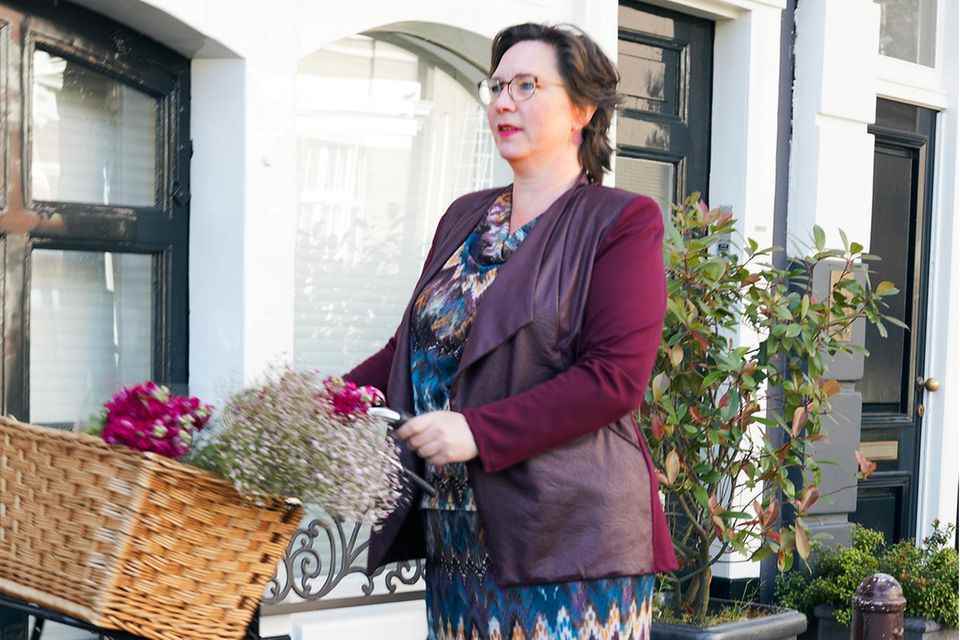
© Marijke van der Veen
The designer: Marijke van der Veen
Marijke’s great passion is sewing. After training as a cutting technician at a fashion school, she worked for well-known Dutch fashion brands such as Vanilia, Turnover, Summum-Woman, Edgar Vos and Mart Visser for almost three decades. After suffering from breast cancer and completing treatment, the Dutchwoman realized her dream of having her own label for sewing patterns. For this purpose, the designer, who describes herself as a curvy woman, prefers to create cuts for larger sizes in which every woman can feel beautiful. Under her label “Marijke-Sewing-Pattern” and on her website you will find instructions and sewing patterns in sizes 36-56 and cup size A – H. Marijke focuses on practical and comfortable clothing with an elegant finish that conjures up a feminine silhouette – while also designing only what she would wear herself. In the accompanying video tutorials, the passionate seamstress shares the experiences and tips she has gained over the years on processing the fabrics, various sewing techniques and a good fit.
Would you like to get to know more easy and beautiful patterns from Marijke? Then let yourself be inspired here: marijke-sewing-patterns.de.
